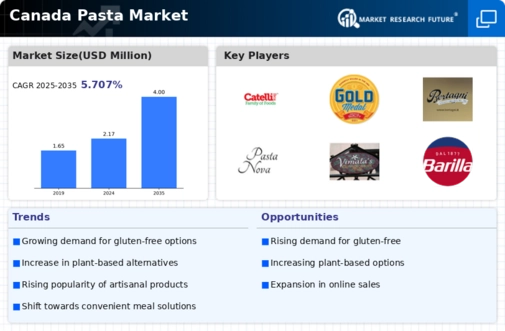Rising Demand for Organic Products
The pasta market in Canada is experiencing a notable shift towards organic products. Consumers are increasingly prioritizing health and sustainability, leading to a surge in demand for organic pasta options. According to recent data, organic pasta sales have grown by approximately 15% annually, reflecting a broader trend in the food industry. This shift is driven by a growing awareness of the benefits of organic ingredients, including reduced pesticide exposure and enhanced nutritional value. As a result, manufacturers are adapting their offerings to include organic varieties, which may contribute to a more diverse product range in the pasta market. This trend not only caters to health-conscious consumers but also aligns with environmental sustainability goals, potentially influencing purchasing decisions across various demographics.
Increased Focus on Convenience Foods
The pasta market in Canada is witnessing a significant trend towards convenience foods, driven by busy lifestyles and the demand for quick meal solutions. Consumers are increasingly seeking products that offer ease of preparation without compromising on quality. Ready-to-cook pasta options, such as pre-packaged meals and microwaveable varieties, are gaining popularity, reflecting a broader shift in consumer behavior. Recent statistics indicate that convenience pasta products have seen a growth rate of approximately 12% in sales over the last year. This trend suggests that manufacturers in the pasta market are likely to invest in developing innovative packaging and meal solutions that cater to the needs of time-strapped consumers, thereby enhancing their market presence.
Culinary Diversity and Ethnic Flavors
The pasta market in Canada is increasingly influenced by culinary diversity and the incorporation of ethnic flavors. As the population becomes more multicultural, there is a rising interest in diverse pasta dishes that reflect various global cuisines. This trend is evident in the growing popularity of specialty pasta types, such as Asian noodles and Mediterranean varieties, which are gaining traction among Canadian consumers. Market data indicates that sales of specialty pasta have increased by around 10% over the past year, suggesting a shift in consumer preferences towards more adventurous and flavorful options. This culinary evolution not only enhances the appeal of the pasta market but also encourages innovation among manufacturers, who are likely to experiment with new flavors and ingredients to meet evolving consumer tastes.
Technological Advancements in Production
Technological advancements are playing a pivotal role in shaping the pasta market in Canada. Innovations in production processes, such as automation and improved milling techniques, are enhancing efficiency and product quality. These advancements allow manufacturers to produce a wider variety of pasta shapes and types, catering to diverse consumer preferences. Additionally, the integration of technology in supply chain management is streamlining operations, reducing costs, and improving distribution efficiency. Market analysis suggests that companies adopting these technologies may experience a competitive edge, as they can respond more swiftly to changing consumer demands. As the pasta market continues to evolve, the embrace of technology is likely to be a key factor in driving growth and innovation.
Sustainability and Eco-Friendly Packaging
Sustainability is becoming a crucial driver in the pasta market in Canada, as consumers increasingly demand eco-friendly packaging solutions. The growing awareness of environmental issues has prompted manufacturers to explore sustainable practices, including the use of biodegradable and recyclable materials. Recent surveys indicate that over 60% of Canadian consumers are willing to pay a premium for products that utilize sustainable packaging. This trend not only reflects a shift in consumer values but also presents an opportunity for brands to differentiate themselves in a competitive market. As the pasta market evolves, companies that prioritize sustainability may enhance their brand loyalty and appeal to environmentally conscious consumers, potentially leading to increased market share.






















Leave a Comment